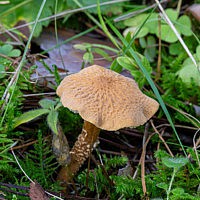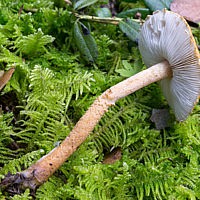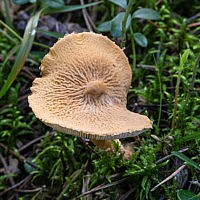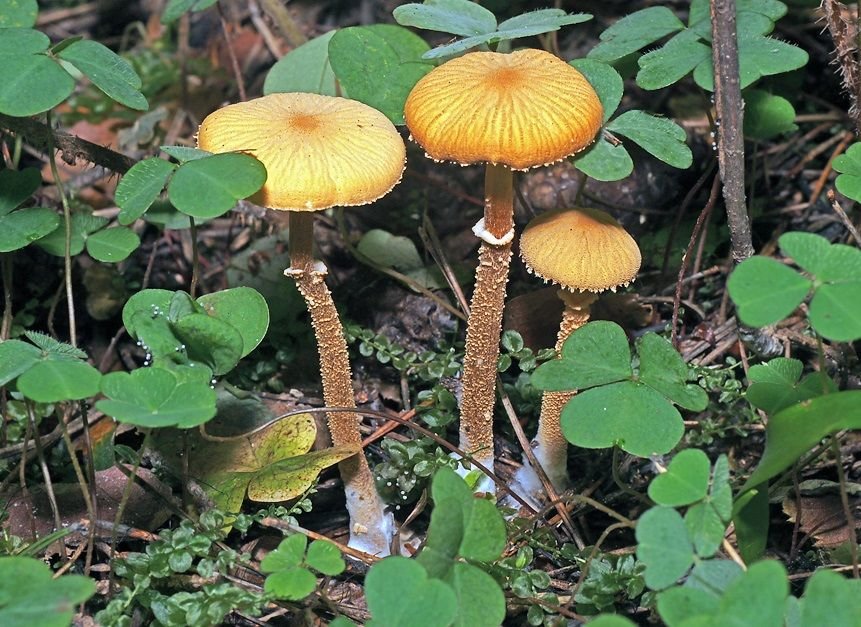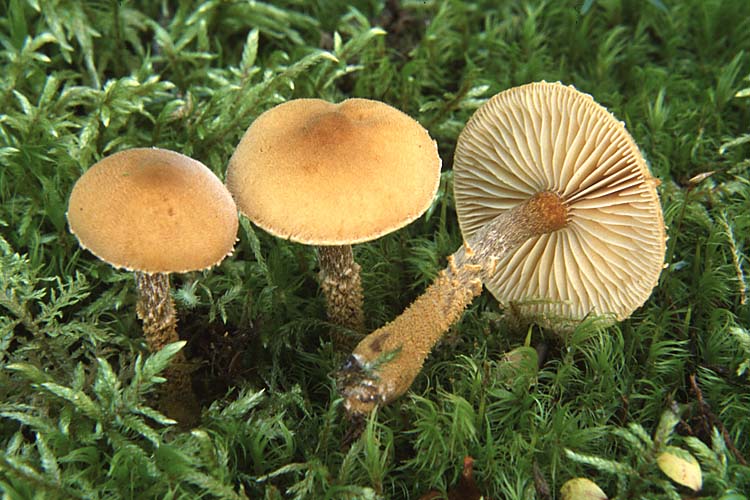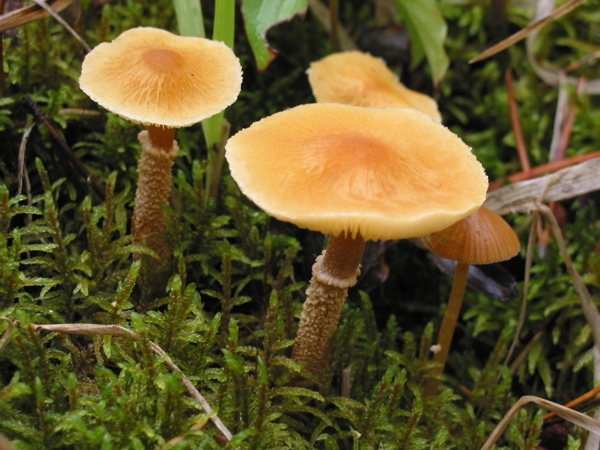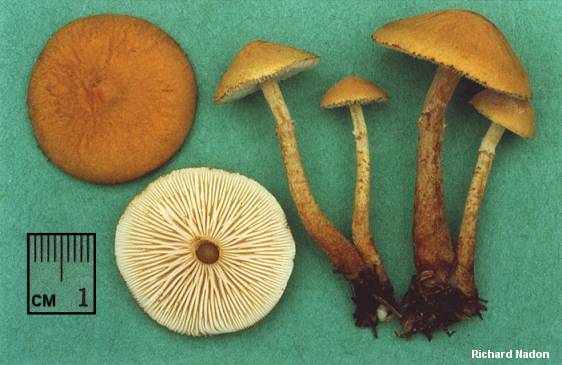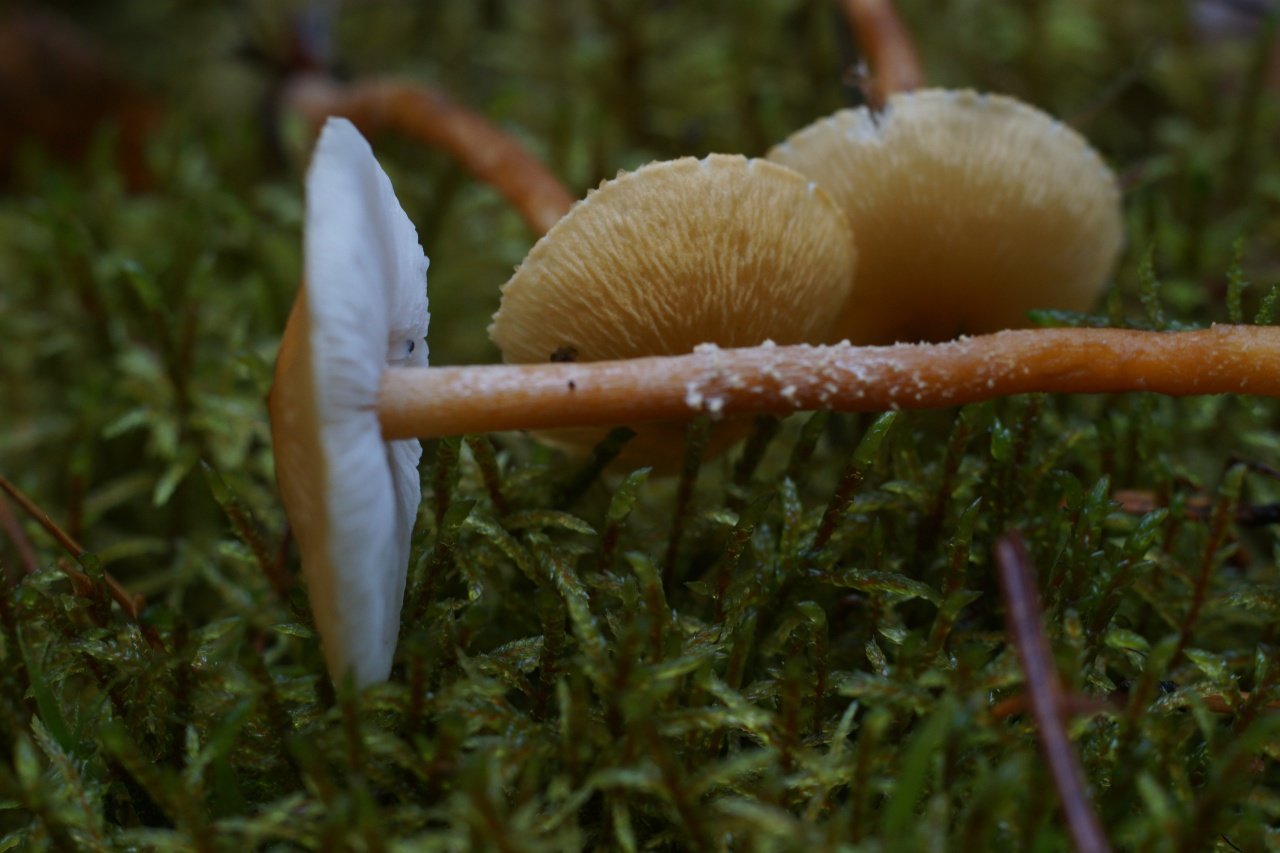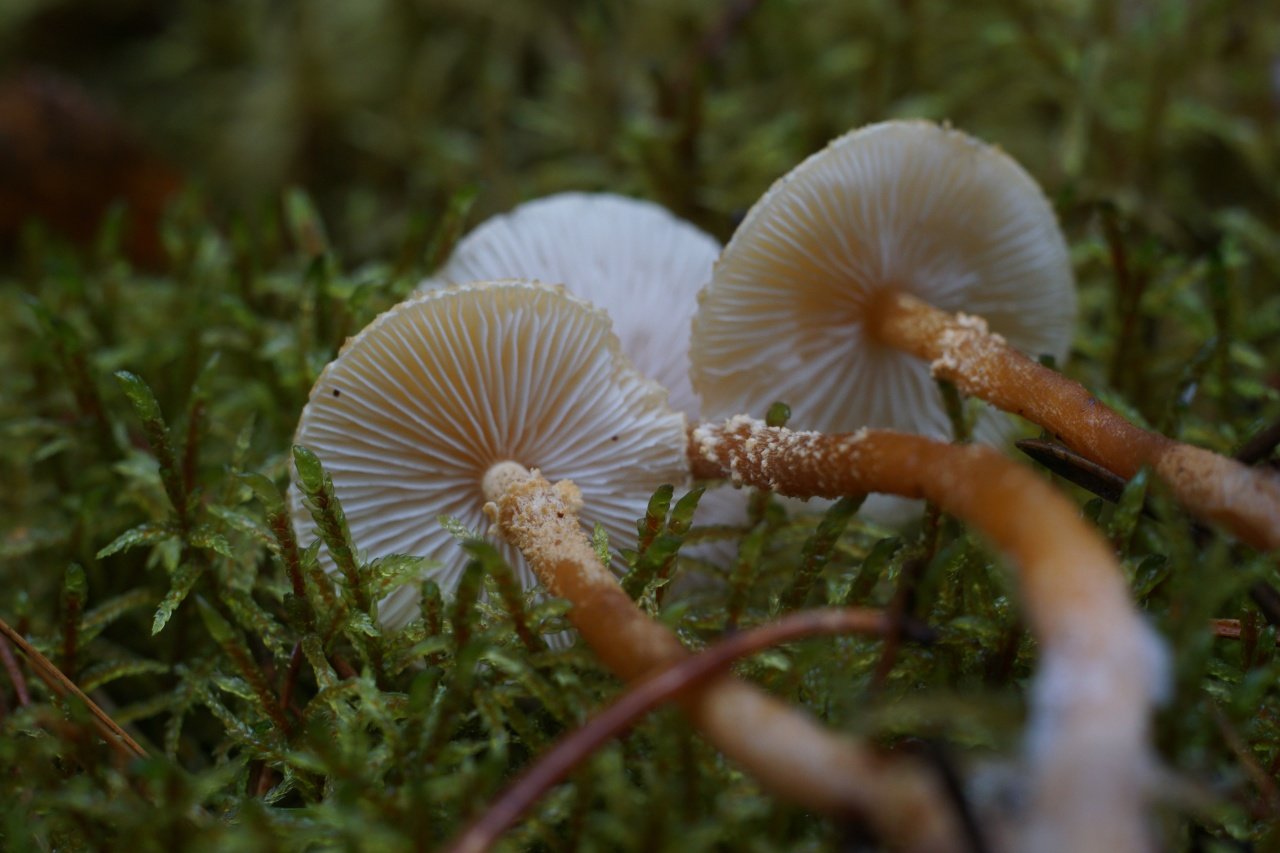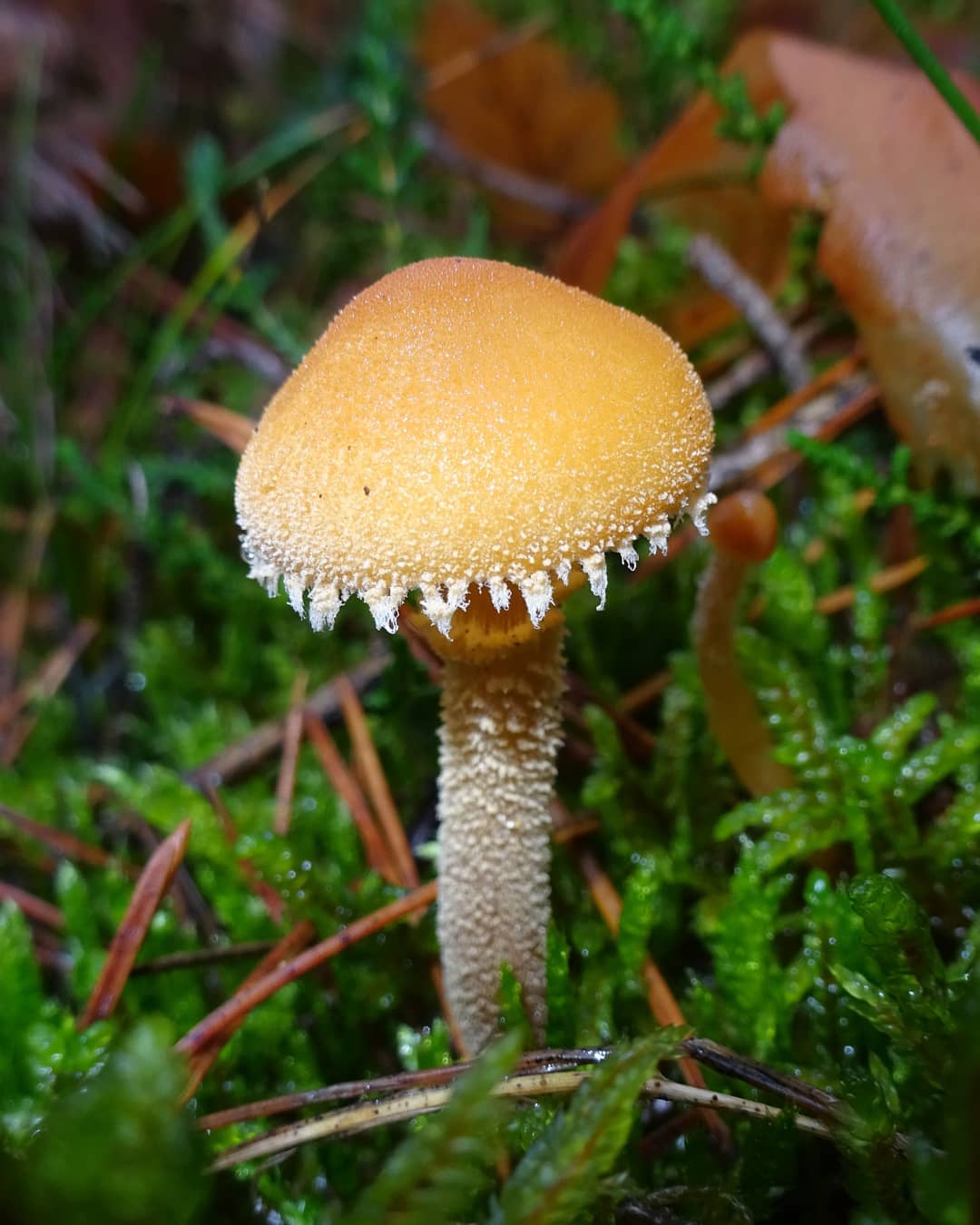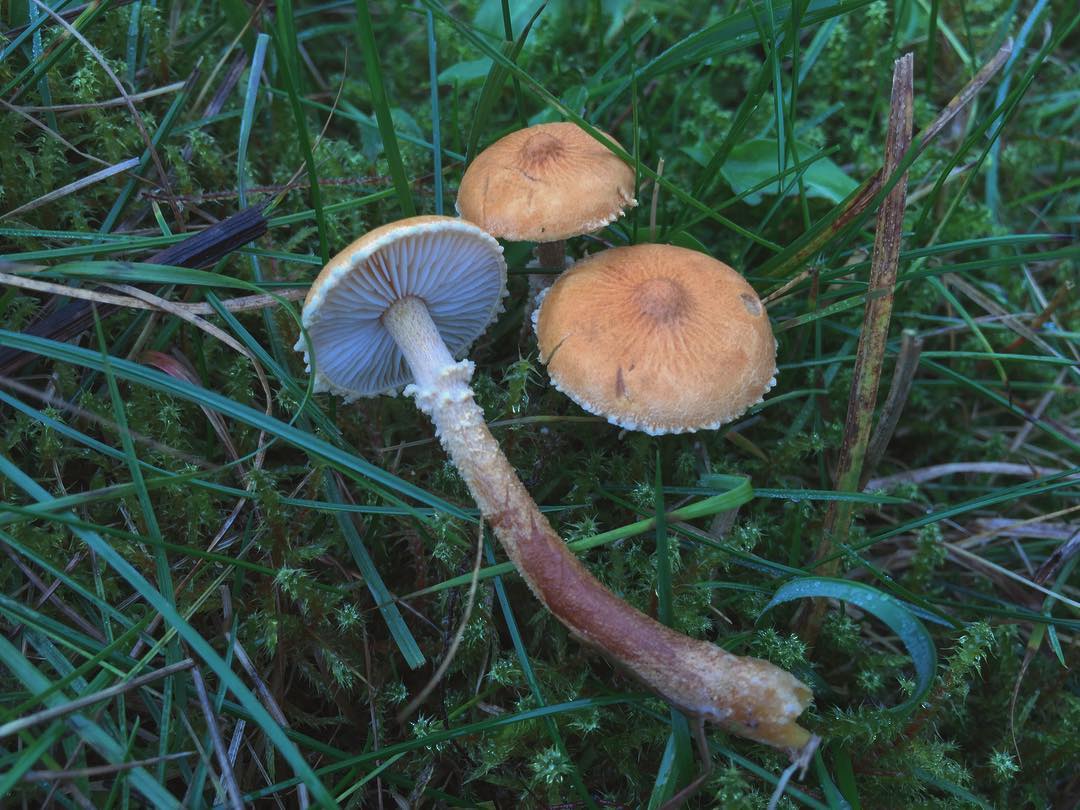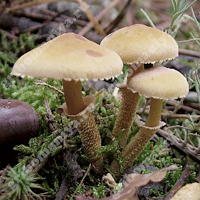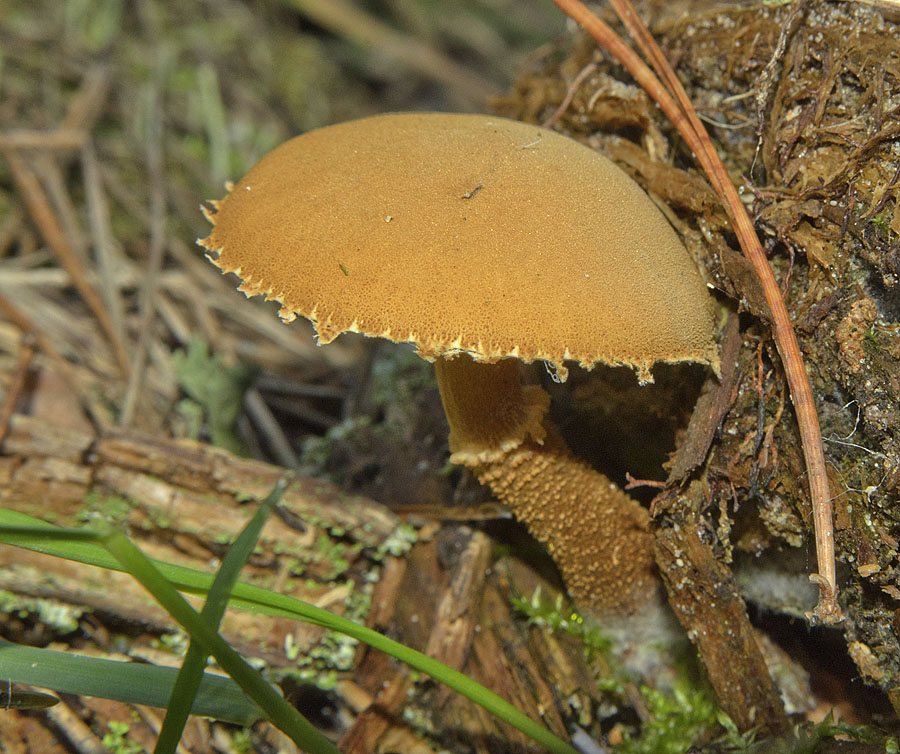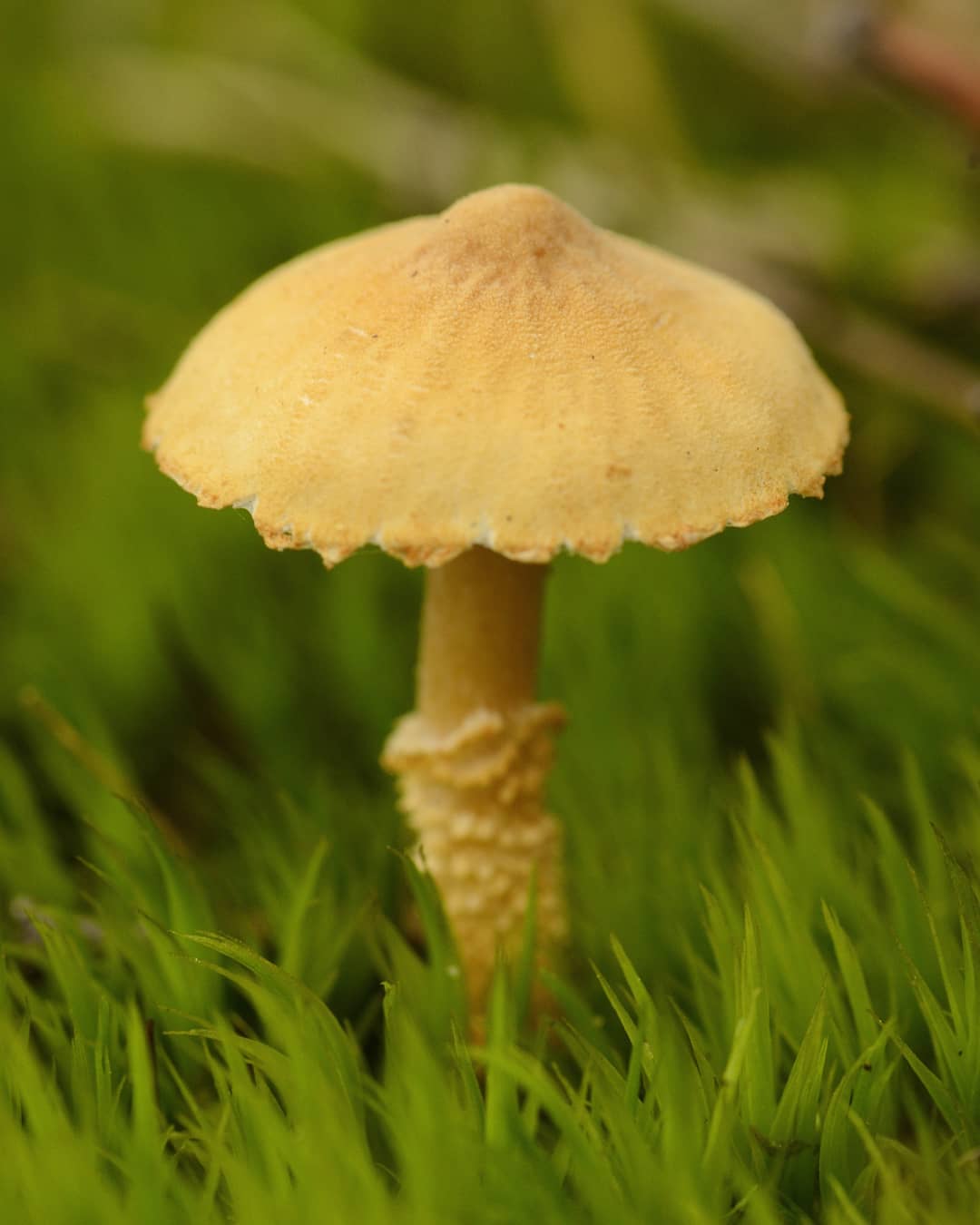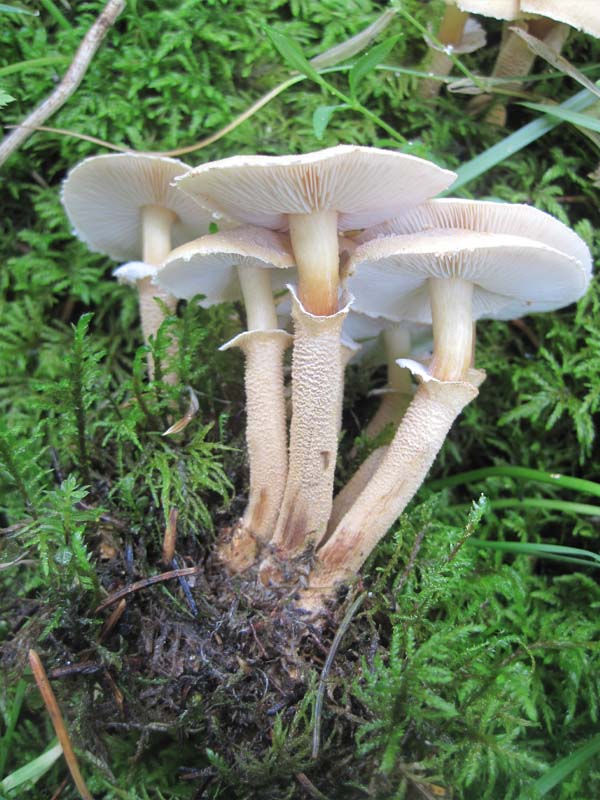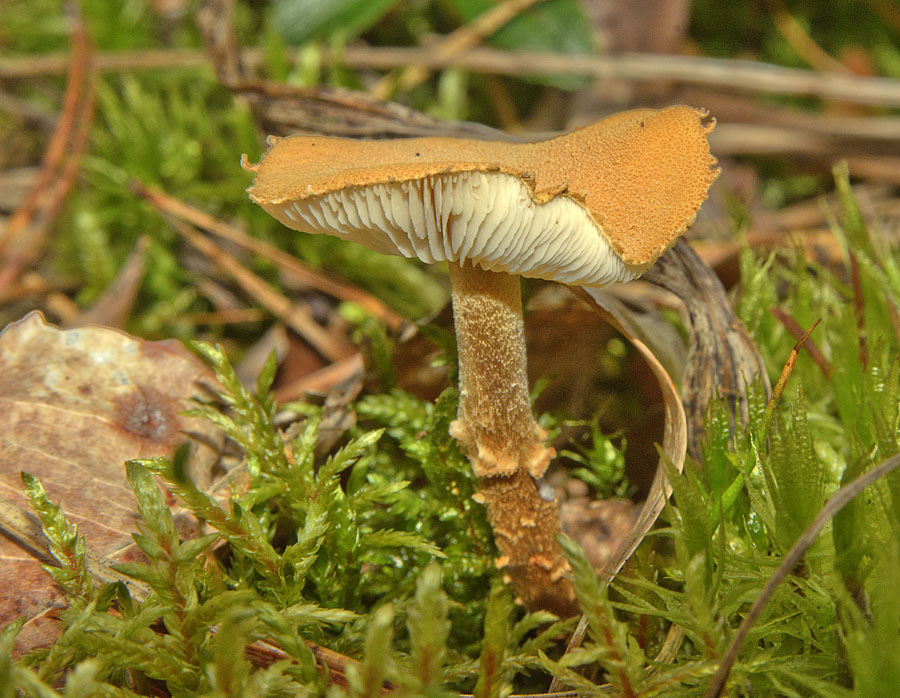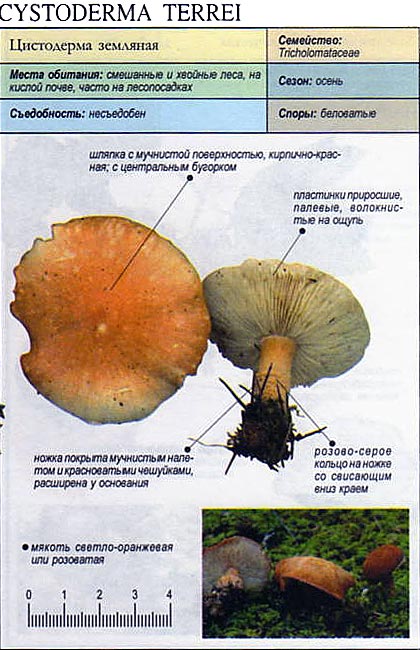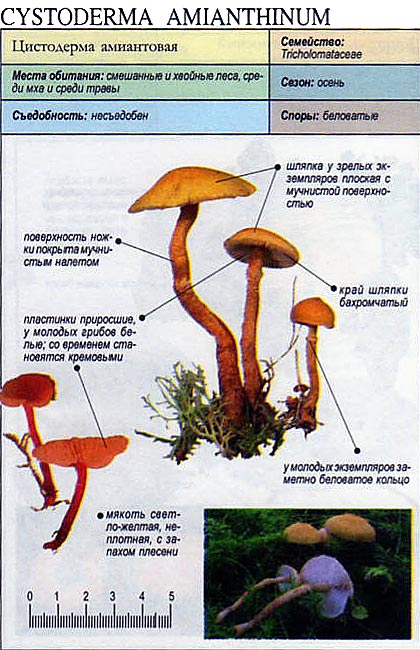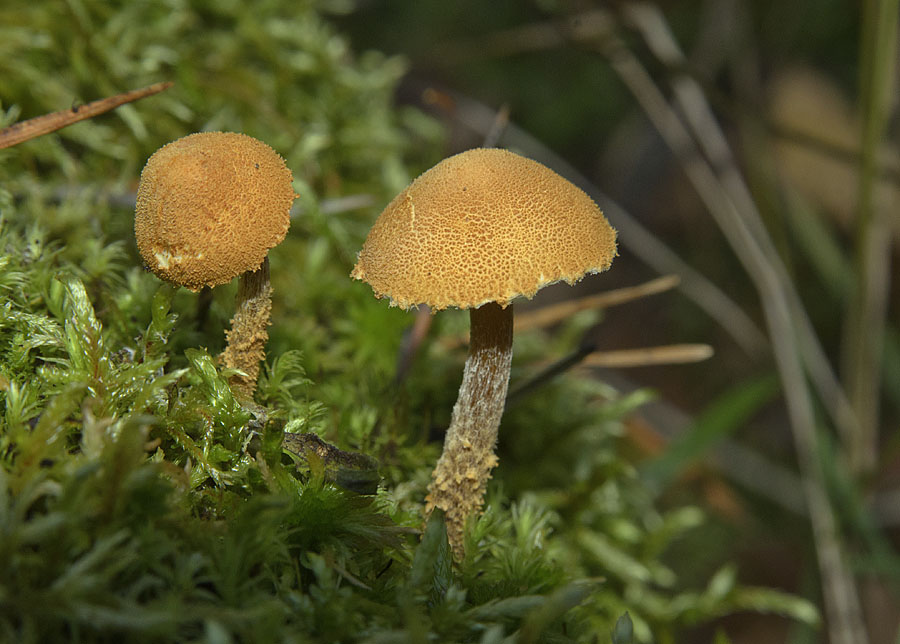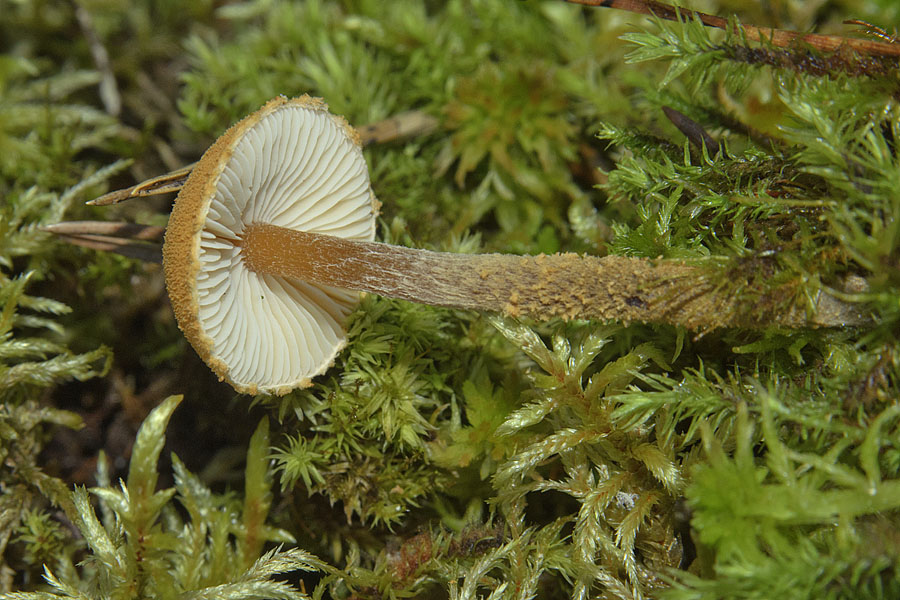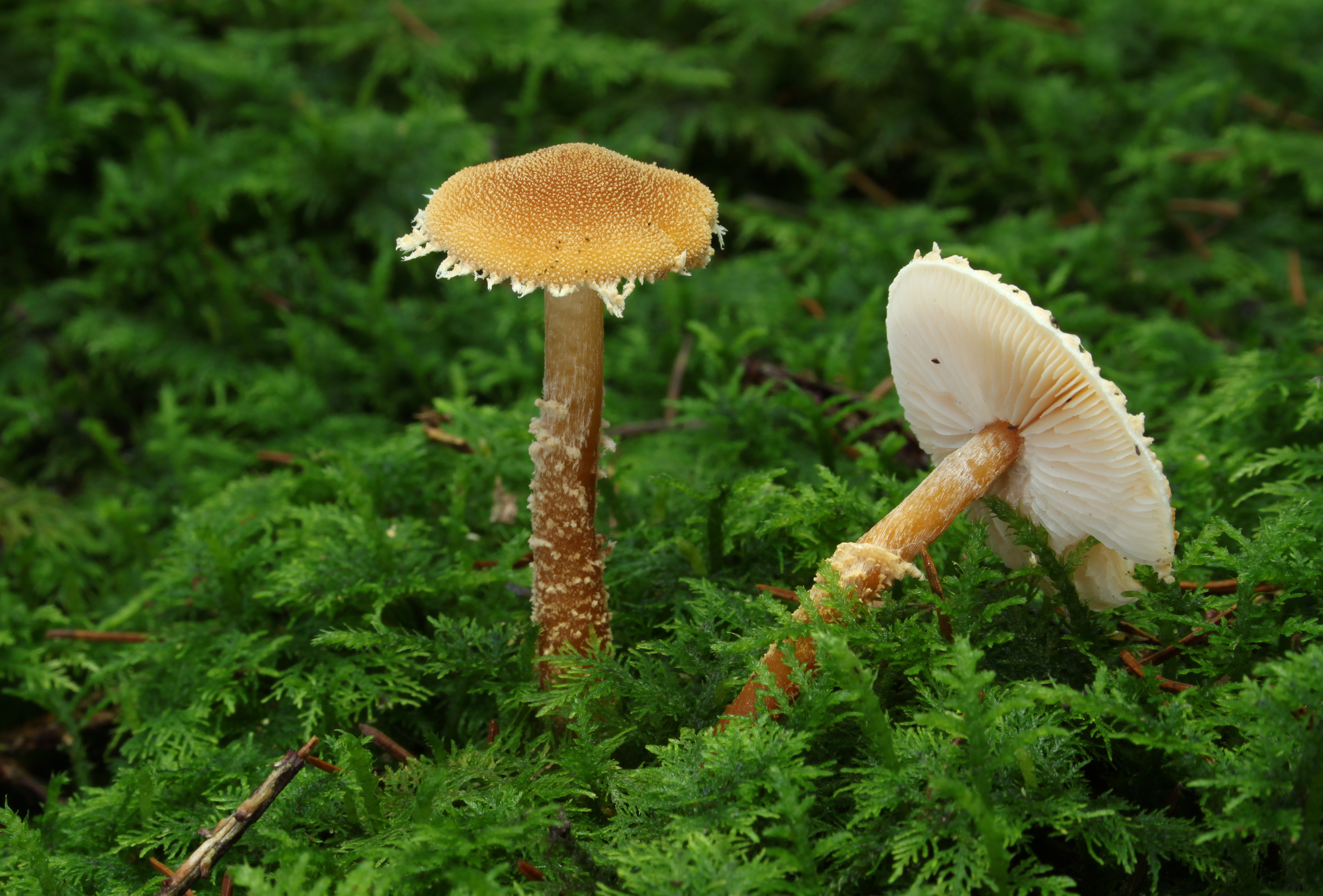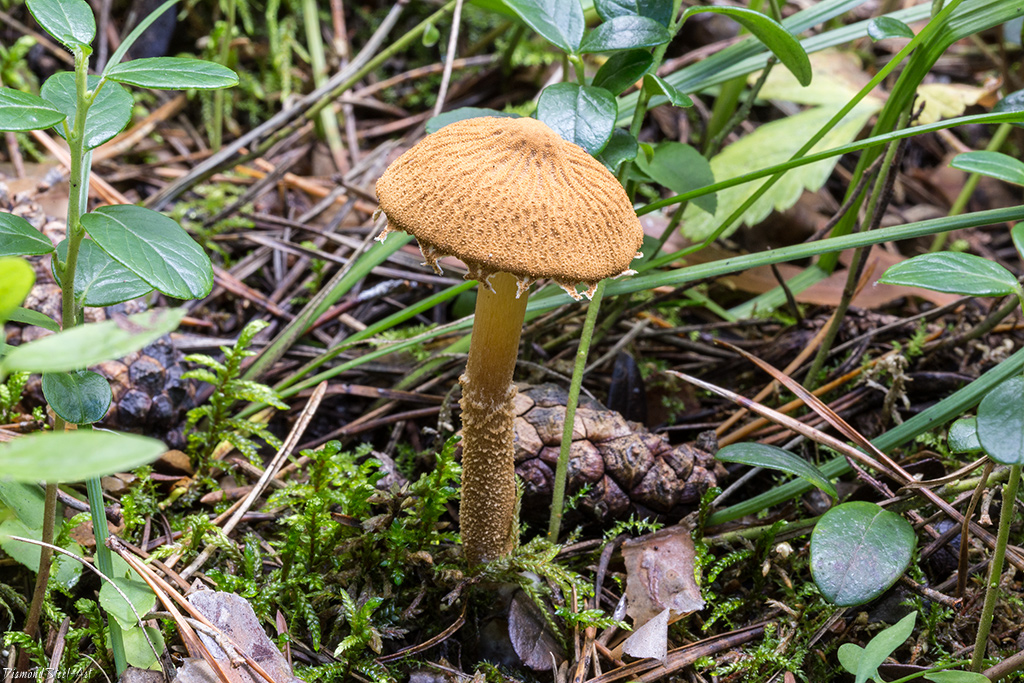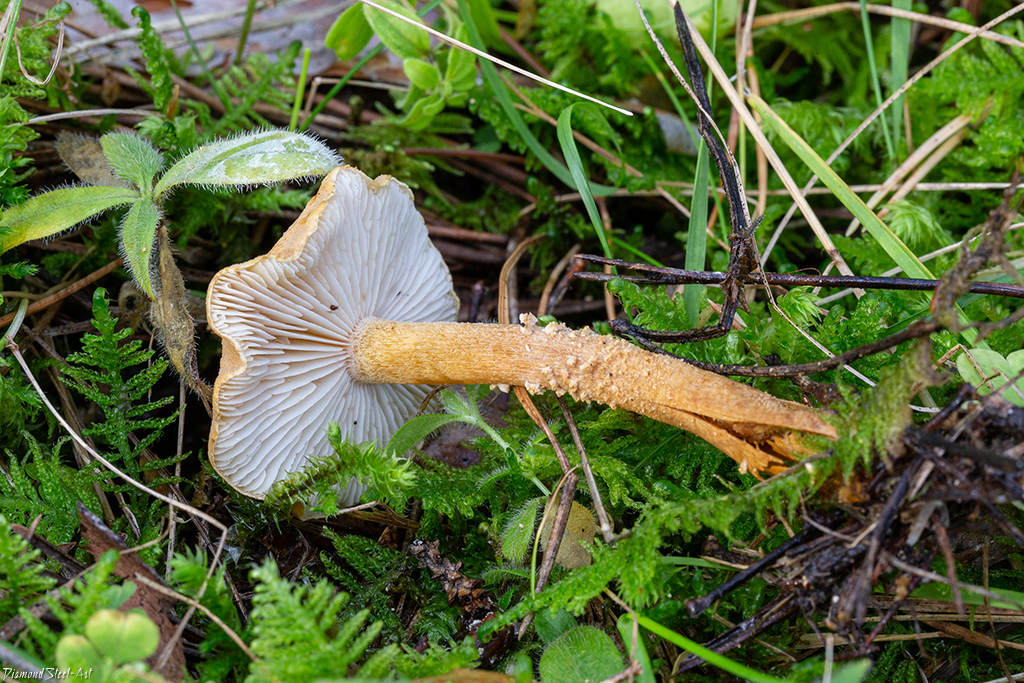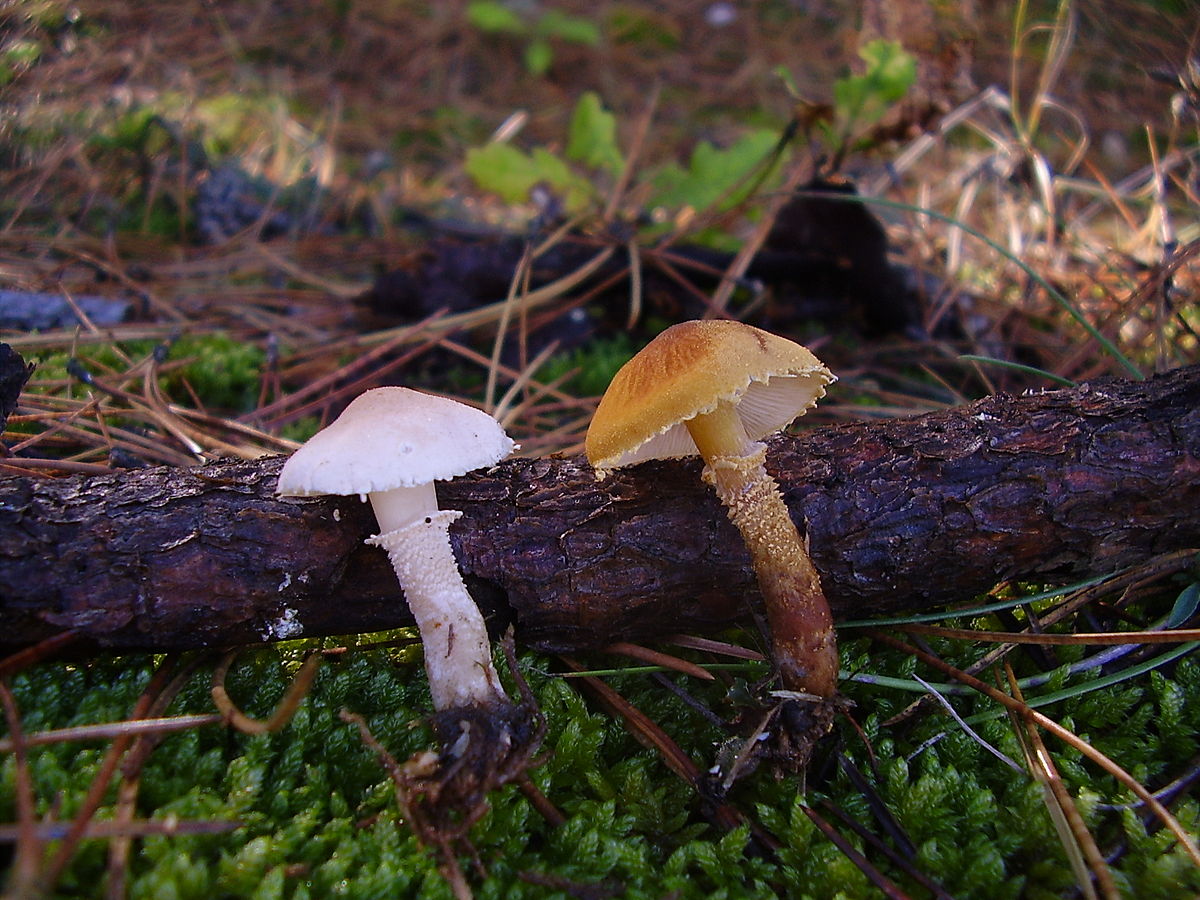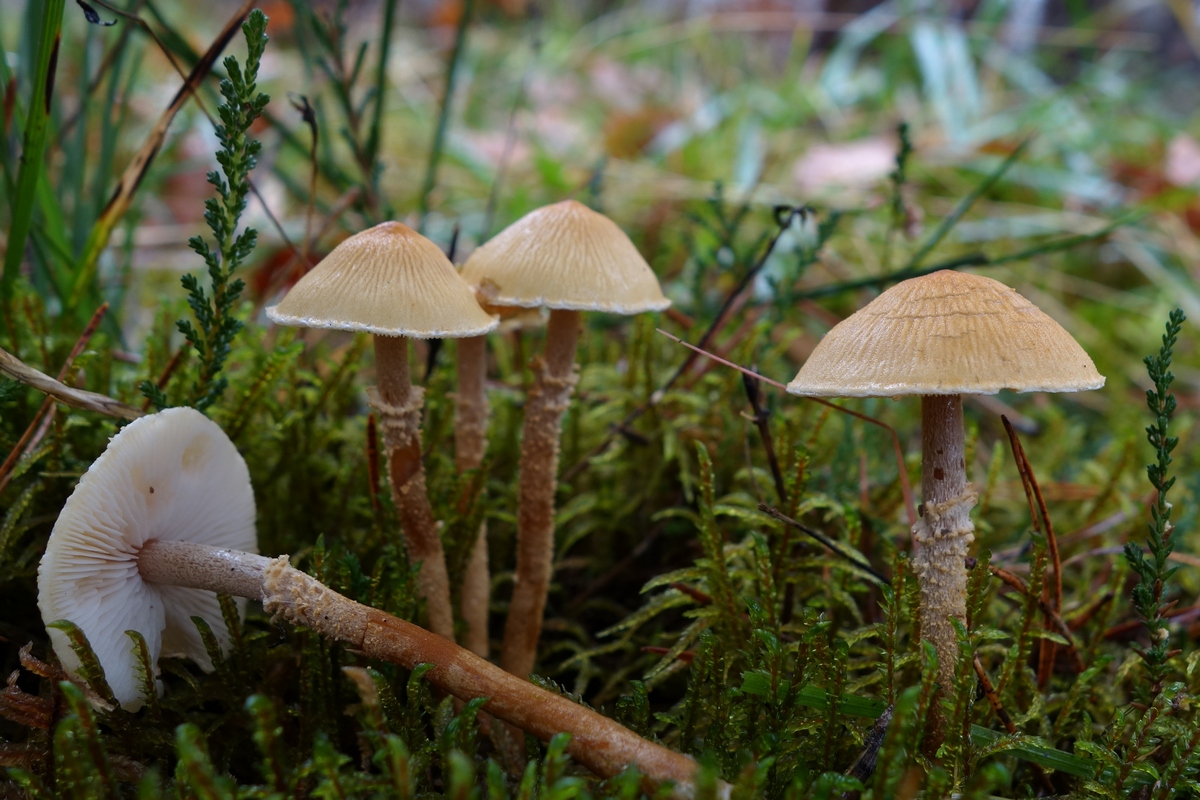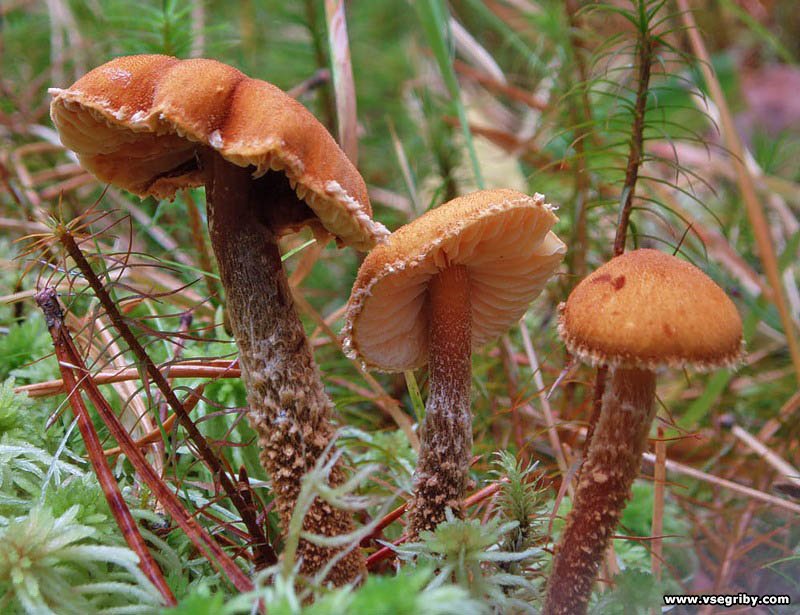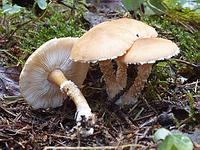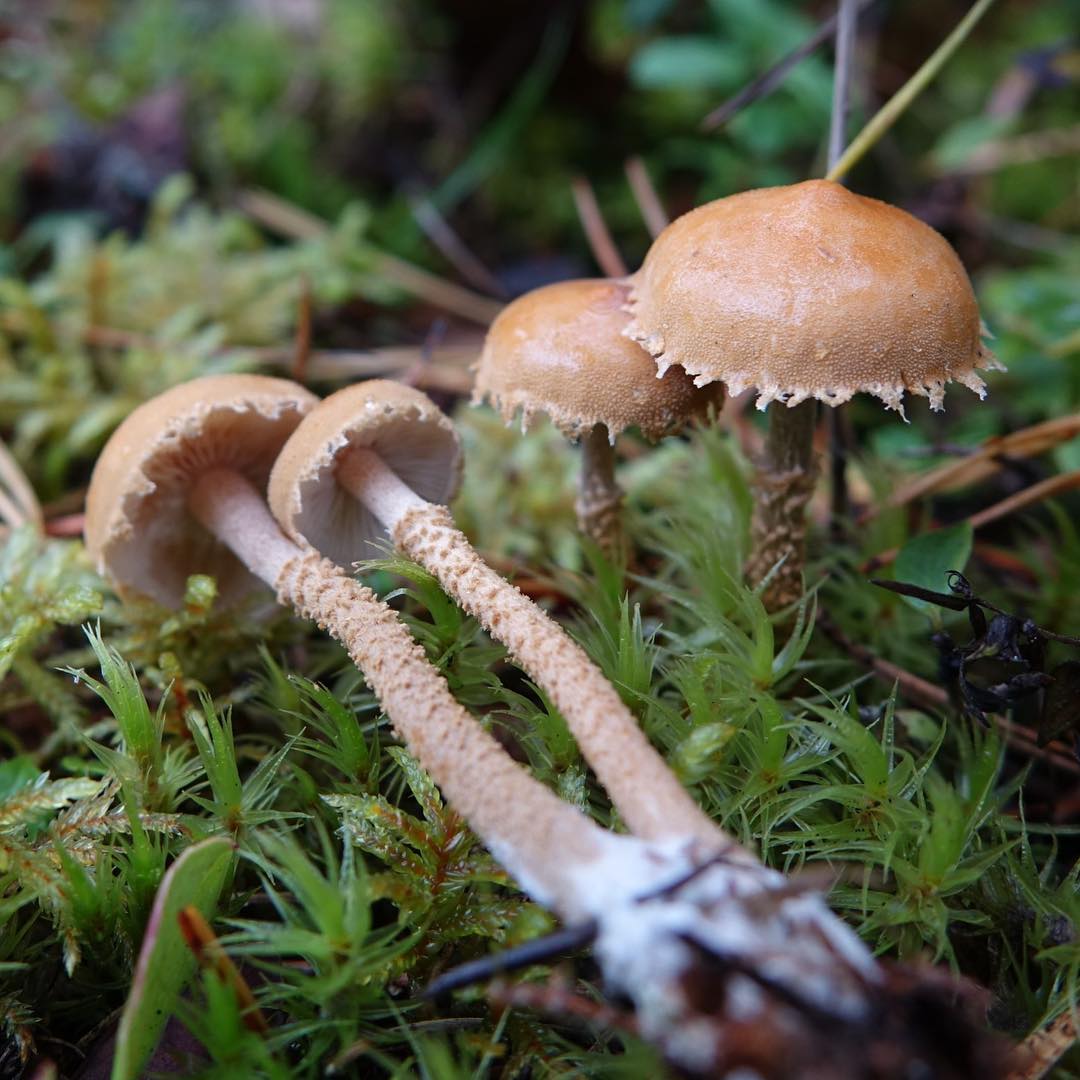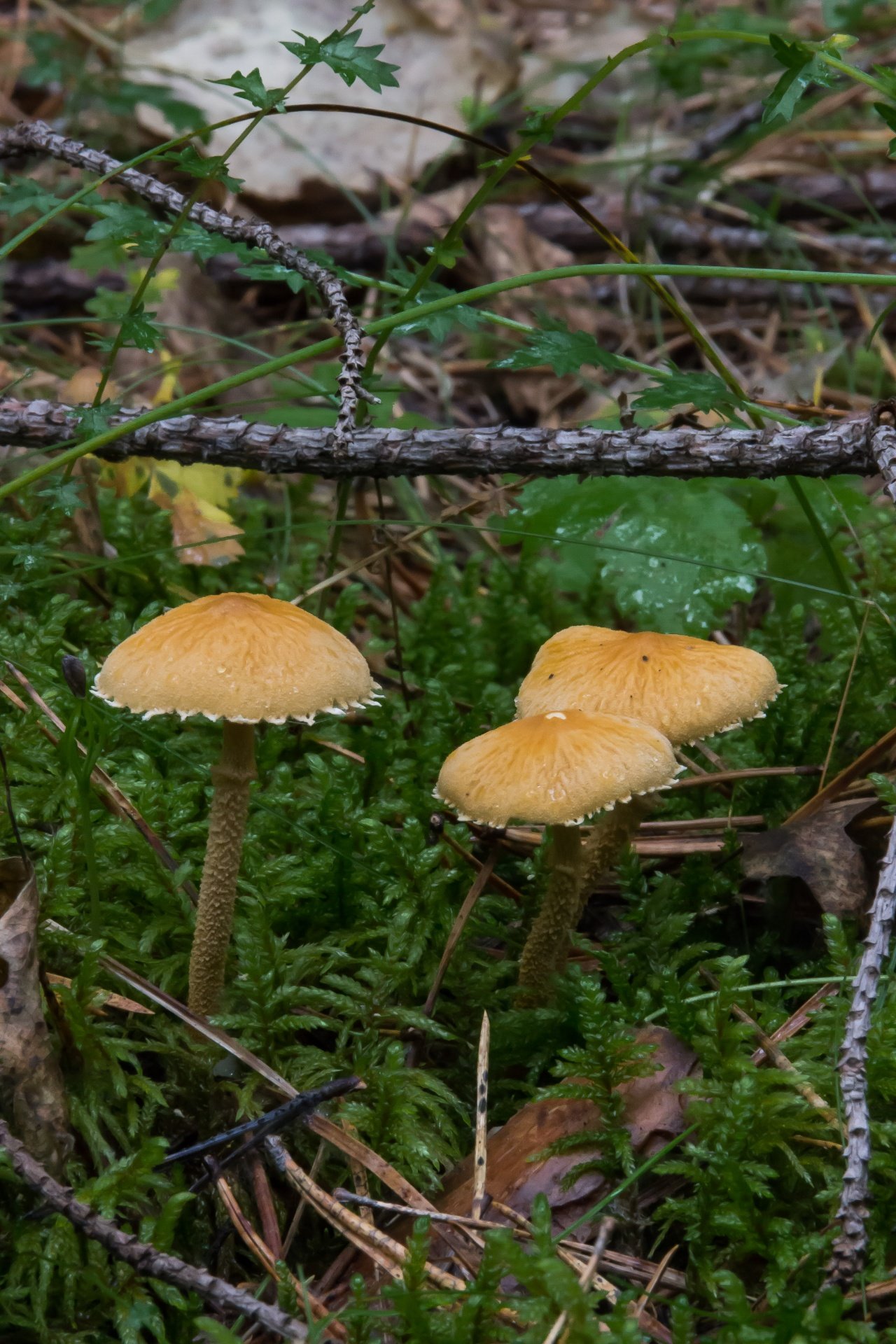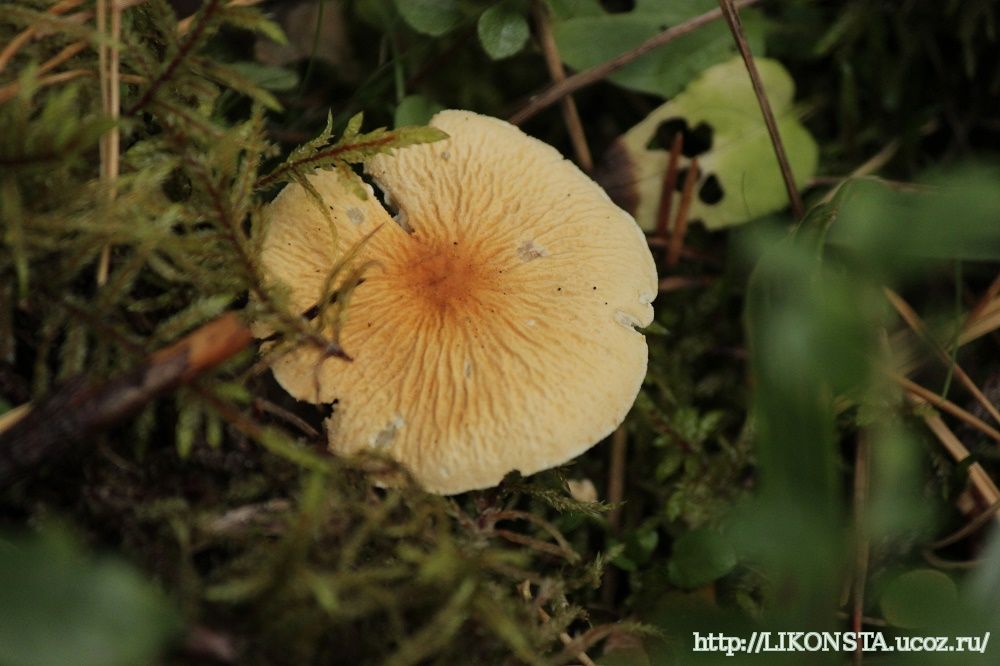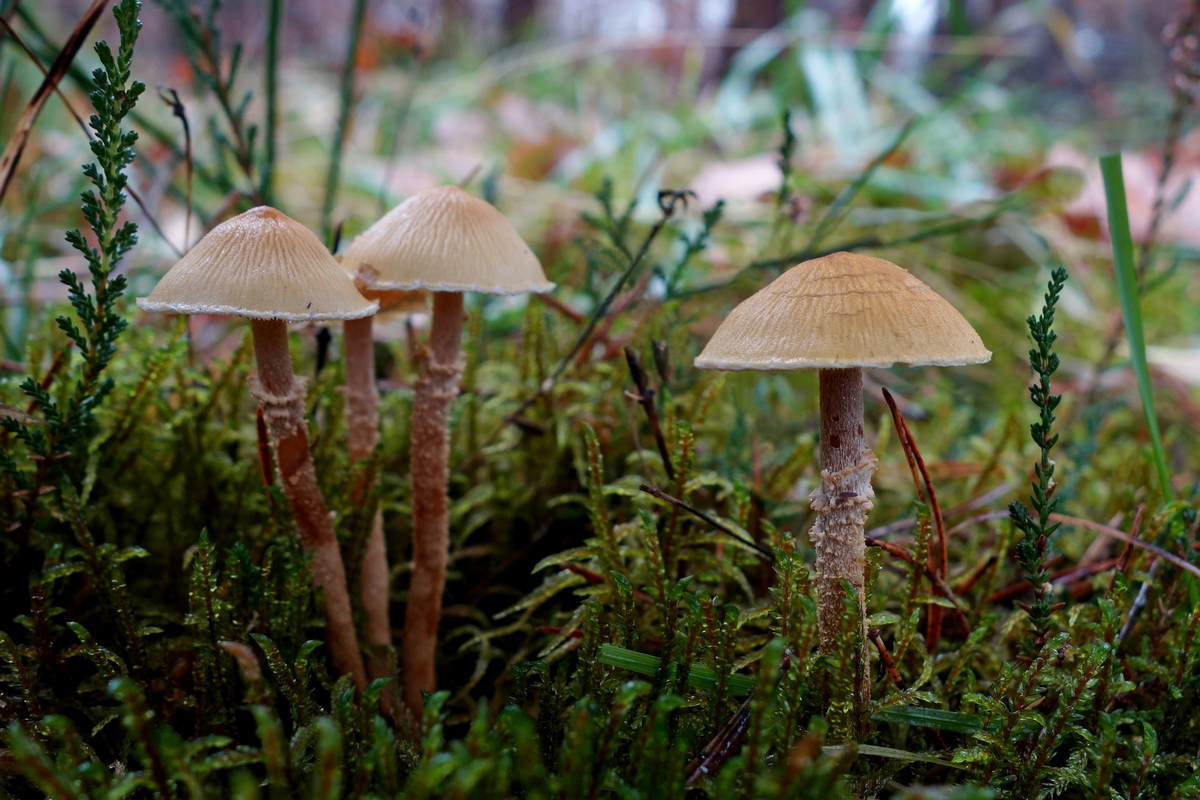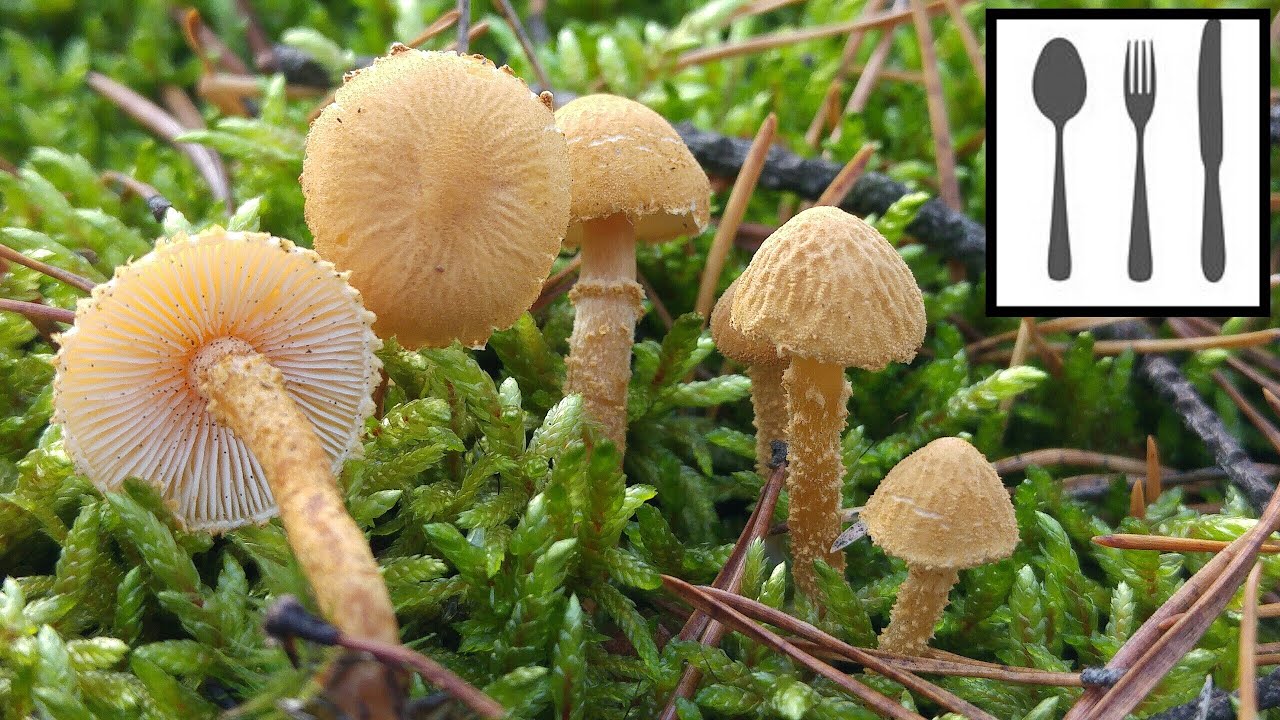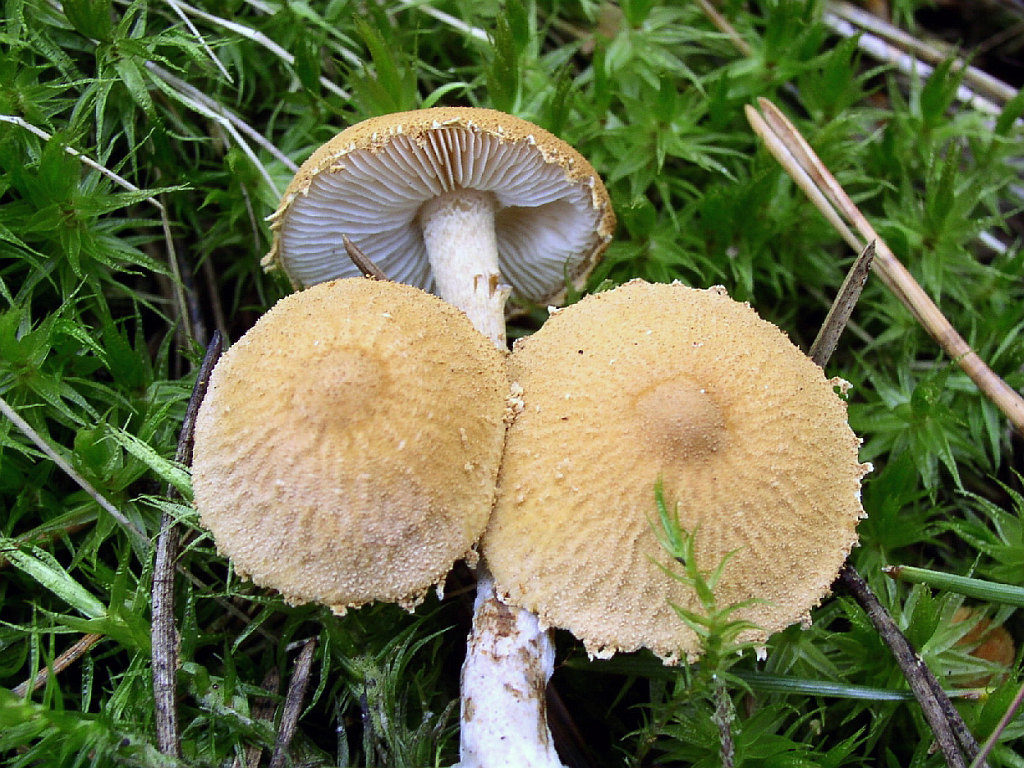Cystoderm red (cinnabar red, Umbrella red, Cystodermella cinnabarina) as they look
Cystoderm red (Umbrella red): photo and description
| Name: | Cystoderm is red |
| Latin name: | Cystodermella cinnabarina |
| View: | Edible |
| Synonyms: | Cystoderm cinnabar red, Umbrella red, Cystoderma cinnabarinum |
| Specifications: |
|
| Systematics: |
|
Red cystoderm is an edible member of the Champignon family. The species has an attractive red color and prefers to grow from July to September among spruce and deciduous trees. In order not to make an error during mushroom hunting and not to put false twins in a basket, it is necessary to analyze the external characteristics of the species.
How does cystoderm look like red
Red cystoderm is a bright, but rarely seen species of the mushroom kingdom. To recognize it and not be confused with toxic twins, you need to know the description of the mushroom and get to know its photo well.
Description of the hat
The cap is small, no more than 8 cm in diameter. In young specimens, it has a bell-shaped appearance; in adulthood, it straightens, leaving a small mound in the very center. The bright orange surface is decorated with smooth, fine-grained, red scales.
The spore layer is formed by thin often whitish or coffee-colored plates. The plates are fragile, partially adhered to the stem. The species reproduces by elongated spores.
Leg description
The leg is elongated, up to five centimeters long. In the middle, it is hollow and fibrous, thickens downward. The surface is covered with countless granular scales of pink or light red color. It becomes discolored as it grows older.
Eat a mushroom or not
This representative is edible, has a whitish pulp with a pleasant mushroom aroma and taste. Before cooking, the collected mushrooms are boiled in a matter of minutes, fried, stewed and canned.
Where and how it grows
Cystoderm prefers to grow among coniferous trees in small families, less often single specimens, in regions with a climate of temperate latitudes. Begins fruiting from July to early October. Mushroom picking is best done in dry, sunny weather, away from highways and industrial enterprises.
Doubles and their differences
This representative has similar twins. These include:
- Grainy - a conditionally edible species with an ovoid brown-orange cap. The pulp is dense, odorless and tasteless. It grows in coniferous forests in small families. Fruiting comes from August to October.
- Amiantovaya is a conditionally edible mushroom with a small convex cap and a long cylindrical stem. The pulp is light, tasteless, but with a faint offensive odor. Grows among conifers and deciduous trees from August to October.
Conclusion
Red cystoderm is an edible representative of the mushroom kingdom. It can often be found in coniferous forests from July to October. Before cooking, the collected mushrooms are thoroughly soaked and boiled. Prepared cystoderms are good fried, stewed and canned. Skilled mushroom pickers recommend passing by little-known specimens so as not to harm yourself and your own family.
Scaly cystoderm (Scaly umbrella, Cystoderma carcharias) how mushrooms look, where and how
Scaly cystoderm (Scaly umbrella): photo and description
| Name: | Scaly cystoderm |
| Latin name: | Cystoderma carcharias |
| View: | Conditionally edible |
| Synonyms: | Odorous cystoderm, Scaly umbrella, Shark cystoderm |
| Specifications: |
|
| Systematics: |
|
Scaly cystoderm is a lamellar edible mushroom from the Champignon family. Due to its similarity with toadstools, virtually no one collects it. But it is advisable to know this rare mushroom, and if there are few others, then such a specimen can be replenished with a basket.
How does the scaly cystoderm look
Odorous cystoderm or scaly umbrella (these are other names for the mushroom) has a light pulp with a weak taste of wood. Consists of a cap and a leg. On the back of the cap, permanent plates of cream or light brown color are noticeable. Propagated by white spores.
Description of the hat
The development of the scaly cystoderm cap is as follows: conical (hemispherical) in youth, it becomes curved outward with a middle tubercle in adulthood with a diameter of up to 6 cm.The color is yellowish or gray-pink, but fades to white over the years. Dry surface on a matte base covered with white fine-grained powder of maturing spores. A fringe in the form of hanging flakes is visible at the edges of the cap.
Leg description
The hollow in the middle of the leg of the scaly cystoderm has a height of 3-5 cm and a diameter of up to 5 mm. It is divided into two halves by a ring with a lapel: the upper one is light and smooth, the lower one is pimply.
Eat a mushroom or not
Does not have high-quality gustatory parameters. In terms of nutritional value, it belongs to the 4th category. It can be used for making soups and other gastronomic dishes. It is recommended to boil for at least 15 minutes. The broth is drained.
Where and how it grows
Cystoderm grows on the ground in moss or on fallen leaves and needles in mixed pine and coniferous forests. Prefers chalky soils. Distributed mainly in North America, Central Asia, Europe. In our country, it is a rare mushroom. There are single specimens and group shoots. The growing period is the second part of August and until November.
Doubles and their differences
There are several variants of this family:
- Cystoderm amianthus. Conditionally edible. It stands out with a more brown color, watery pulp. The leg has no ring.
- The cystoderm is red. It stands out with a reddish or orange tint, a larger cap and a thick leg. Has a mushroom aroma. Edible. You need to boil it.
Conclusion
The scaly cystoderm is an exotic mushroom. Therefore, it is better for novice mushroom pickers not to take the risk of collecting them. Only an experienced lover of quiet hunting can be sure that he has taken a “good” specimen.
Granular cystoderm: photo and description
| Name: | Granular cystoderm |
| Latin name: | Cystoderma granulosum |
| Type of: | Conditionally edible |
| Synonyms: | Agaricus granulosus, Lepiota granulosa |
| Systematics: |
|
Granular cystoderm belongs to the class Agaricomycetes, the Champignon family, the genus Cystoderm. This species was first described in 1783 by the German biologist A. Beach.
What does granular cystoderm look like?
This is a small fragile lamellar mushroom with a rounded convex cap, which straightens during growth, maintaining a slight elevation in the middle.
Description of the hat
The cap of the granular cystoderm has the shape of an egg, it is convex, tucked inward, its surface is warty, covered with flakes, along the edges there is a fringe. In older specimens, it is flat-convex or flat with a bulge in the center, covered with dry fine-grained skin, sometimes with scales, wrinkles or cracks.
The color is ocher or reddish brown, sometimes with an orange tint. The hats are small, ranging in diameter from 1 to 5 cm.The plates are frequent, wide, loose, yellowish or creamy white.
The pulp is light (yellowish or whitish), soft, thin, odorless.
Leg description
The leg is 2-8 cm high and 0.5-0.9 cm in diameter. It has a cylindrical shape and can expand towards the base. The leg is hollow, with a matte dry surface, smooth at the top, with scales at the bottom. The color is like the hat, only lighter, or lilac. There is a reddish ring with a granular structure on the stem, which disappears over time.
Where and how it grows
Granular cystoderm is common in North America, Eurasia, North Africa. Grows in colonies or singly. Found on mosses and soil, mainly in deciduous forests. Sometimes found in conifers and mixed. Prefers to settle on paths, the outskirts of woodlands, pastures overgrown with bushes. The fruiting season is from August to October.
Doubles and their differences
The closest relative is the cinnabar-red cystoderm. Differs in larger size and beautiful color. The cap can reach 8 cm in diameter. It is bright, cinnabar-red, darker towards the center, with a granular powdery skin, white flakes around the edges. At first, it is convex, with an inward-curved edge, with growth it becomes prostrate-convex, tuberous, with a fringe along the edge. The plates are pure white, poorly adherent, thin, frequent; in mature specimens, they are creamy.
The leg is 3-5 cm long, up to 1 cm in diameter. It is hollow, thickened at the base, fibrous. The ring is red or light, granular, narrow, and most often disappears with growth. Above the ring, the leg is light, naked, under it is a reddish, granular-scaly, lighter than the cap.
The flesh is whitish, thin, reddish under the skin. Has a mushroom smell.
Grows mainly in coniferous forests with pines, occurs in groups or singly. The fruiting season is July-October.
Cinnabar-red cystoderm is a rare edible mushroom. Fresh consumption is recommended after boiling for 15 minutes.
Conclusion
Granular cystoderm is a little-known conditionally edible mushroom. It is most common in North America, but it is also quite rare there.
Description
The hat is small, 2-5 cm ∅; in young mushrooms it is conical or hemispherical, later it is flat-convex or flat, with a blunt tubercle in the central part, with a turned, straightened or, sometimes, upwardly curved fringed edge. The color of the cap is from pale reddish-brown to ocher-yellow, darker in the center; in young mushrooms, the surface of the cap is granular and mealy, with flaky remnants of the veil along the edge, in old mushrooms it is dry, often radially wrinkled or folded.
unequal, narrow, frequent, adherent to the stem, white in young mushrooms, later creamy or ocher-yellowish.
Leg 3-7 x 0.4-0.8 cm, cylindrical or tapering upward, solid, later - hollow, fibrous, whitish above the ring, smooth, below the ring - mealy or granular, the same color with the cap. The ring remaining from the yellowish private veil, short lived, is often missing.
The pulp is whitish-yellowish, thin, with an unexpressed flour taste and a weak unpleasant, moldy odor.
The spore powder is white or yellowish.
Micromorphology edit code
Spores 4-7 x 3-4 microns, elliptical, smooth, weakly amyloid.
Color chemical reactions: In KOH, the surface of the cap is rusty red.
Description of cystoderm red
The diameter of the red umbrella hat is small - 5-8 centimeters. Its shape is convex, and the edges are wrapped, over time, the umbrella opens and becomes convex-outstretched, while the edges are lowered. The color of the cap is orange-red, sometimes the center is darker. White flakes run along the edge of the cap.
The plates are thin, often located, poorly adherent. Their color is light - whitish, and eventually becomes cream. Spore white powder. The flesh of this umbrella is thin, whitish in color, with a mushroom smell.
The length of the leg ranges from 3 to 5 centimeters, and the diameter is approximately 0.5-1 centimeters. The shape of the leg looks like a cylinder, its base is thickened. The stem is fibrous, hollow. There is a ring on the leg, above the ring it is smooth whitish or yellowish in color, and under the ring it is reddish, but lighter than the cap. The surface of the leg is scaly-granular. The ring is also granular, narrow, reddish in color, it often disappears with age.
Distribution places of red umbrellas
Red cystoderms bear fruit from July to October. They grow in coniferous forests, most often found in pine forests. Also common in forests mixed with pine. They are rare. They grow singly or in groups.
Taste qualities of red cystoderm
Umbrella red is a little known mushroom, but it is definitely edible. These mushrooms are eaten freshly prepared.
Other mushrooms of this genus
Amianthus cystoderm or amianthus umbrella is a conditionally edible mushroom. The diameter of the cap of this small mushroom is 3-6 cm. A small tubercle is sometimes visible in the center of the cap, the edges are lowered. Over time, the convex shape of the cap changes to a convex-outstretched one.
Its surface is dry, fine-grained. The color of the cap is ocher brown or ocher yellow. The leg is 2-4 centimeters long and about 0.5 centimeters thick. There is a ring on the leg, the color above the ring is yellow, and in the lower part it is yellow-brown or ocher-yellow. The ring quickly disappears.
Amianthus umbrellas bear fruit from August to September. They grow in coniferous and mixed forests. You can find these mushrooms on the litter, in moss, in meadows, in parks. They are rare. They settle in groups.
Granular cystoderm is a conditionally edible mushroom. The diameter of the cap is 1-5 centimeters. At a young age, the shape of the cap is ovoid with a bent edge, its surface is covered with warts and flakes. In mature mushrooms, the shape of the cap changes to an extended one, and the surface becomes fine-grained, dry, and sometimes wrinkled. The color of the cap is ocher-brown or red-brown. The leg is cylindrical, dry, hollow, of the same color with a cap. Young mushrooms have a ring on the stem, but it quickly disappears.
These mushrooms are widespread in North America. They settle alone or in groups. They are found mainly in mixed forests. They grow in soil or moss. Granular cystoderms bear fruit from August to October.
Scaly cystoderm is a lamellar edible mushroom from the Champignon family. Due to its similarity to toadstools, almost no one collects it. However, it is useful to know this rare mushroom, and if there are few others, then such a specimen can be replenished with a basket.
Names and taxonomy
Scientific synonyms:
- Agaricus granulosus var. amianthinus (Scop.) Fr., 1838
- Armillaria amianthina (Scop.) Kauffm., 1923
- Lepiota amianthina (Scop.) P. Karst., 1879
- Lepiota granulosa var. amianthina (Scop.) P. Kumm., 1871
Other Russian names: spinous cystoderm, amiant umbrella.
The species was first described as Agaricus amianthinus in the city of the Italian-Austrian naturalist Giovanni Scopoli. The modern species name was proposed in the city by the Swiss mycologist Victor Fayod.
Generic name of the mushroom Cystoderma comes from the Greek κύστη (kysti), bubble, blister, and δέρμα (derma), leather; species epithet amianthinum - from αμίαντοσ (amiantos), spotless.
Subspecies and forms edit code
- Cystoderma amianthinum f. album (Maire) A.H. Sm. & Singer, 1945 - white-hat form, currently not recognized as a separate taxon;
- Cystoderma amianthinum f. olivaceum Singer, 1945 - distinguished by the olive coloration of the caps of young mushrooms; the form is found in Siberia;
- Cystoderma amianthinum f. rugosoreticulatum (F. Lorinser) A.H. Sm. & Singer, 1945 - a form with a radially wrinkled cap, found in France, sometimes isolated as a separate species Cystoderma rugosoreticulatum (F. Lorinser) Wasser, 1978;
- Cystoderma var. longisporum (Kühner) Locq., 1945 and Cystoderma var.sublongisporum Singer, 1945, are currently isolated as a separate species Cystoderma jasonis (Cooke & Massee) Harmaja, 1978.

